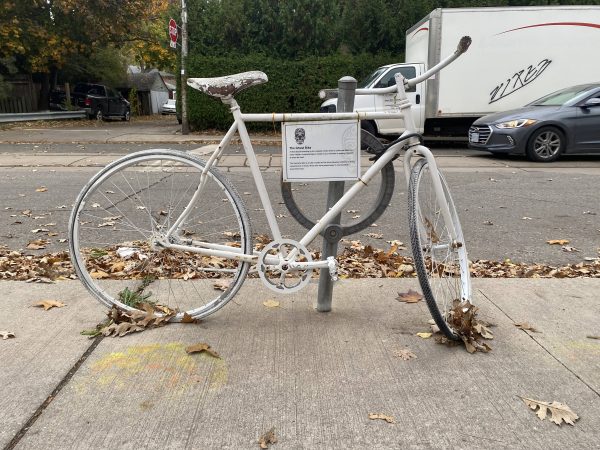Somewhere in this city, there’s a cyclist going about their business who will die in a terrible accident — perhaps sooner, perhaps later — because Doug Ford thinks his campaign to remove bike lanes will make for an excellent wedge issue in the forthcoming provincial election.
That individual has a family and friends, perhaps a pet, interests, quite possibly a job they can reach on two wheels. They might have bought a cargo bike recently, or are trying out an electric model. Maybe they’re using bikeshare because their apartment has no parking spaces. Whatever the constellation of personal details, that person is out there; they just don’t know that they’re doomed. Maybe it’s your best friend. Maybe it’s your child.
Maybe it’s you.
Quite apart from the shocking callousness of Ford’s move (the details of which were posted on Halloween on the Environmental Bill of Rights registry), the highly dubious justification and the jurisdictional bullying, you have to wonder who will wear responsibility — not just moral but also legal — for removing a form of protection that we know saves lives.
Under the Canadian constitution, the provinces call the shots when it comes to municipal government. Provincial laws set out what cities can and can’t do, and provincial regulations govern the services that municipalities provide.
Yet the Ontario government delegates responsibility for enormously complicated systems — water/waste water, public health, etc. — to municipalities, on the understanding that they’ll deliver these services in ways that protect the public.
When governments — in this case, the provincial government — knowingly and recklessly take steps to endanger the public, are they not violating their duty of care? Surely the bike lane removal order is no less negligent than an edict to stop treating fresh water. After all, in both instances, we know what’s going to happen.
I don’t want to argue here that the City of Toronto has been a paragon of responsibility when it comes to pedestrian and cyclist safety. We’ve lived for years in a city that tolerates street racing and flagrant violations of traffic laws even as it has, until fairly recently, done as little as humanly possible to ensure the safety of cyclists.
Yet over the past decade, there’s been a growing recognition, both inside local government and on council, that the City of Toronto needs to take positive steps to reduce pedestrian and cyclist accidents and deaths.
Again, I don’t want to argue that the City, at least initially, leaned into Vision Zero. But there’s been progress — not just the physically protected bike lanes, both built and in the works, but far more traffic cameras, speed limit reductions, restrictions near schools, etc.
There’s solid empirical evidence in Toronto that these measures are beginning to produce results. In Sweden, where these ideas first germinated in the late 1990s, Vision Zero policies have halved the number of road deaths. U.S. cities with Vision Zero programs have had more mixed results, according to a 2023 study published by the International Journal of Transportation Research. The authors, nonetheless, pointed out that their evidence indicates that “cities with high walking, biking, and transit mode share and those that focused on walking and biking in their Vision Zero action plans experienced the best outcomes.”
Besides all the international data that bike lanes prevent injuries and deaths, there’s no convincing evidence in Toronto that bike lanes have done any more to contribute to gridlock than factors such as major infrastructure construction projects (Gardiner, Ontario Line, Finch West LRT, etc.), lane closures for high-rise construction, and the traffic that organically clogs the major arterials in the inner suburbs, especially close to the 400-series highway on/off ramps.
The City’s transportation department has all the data about the through-put on major roads, the busiest intersections, and so on. Very little of it involves the bike lanes along Yonge, Bloor and University. Yet as Doug Ford and his late brother Rob did back when they set out to zap the Jarvis Street bike lane and disparage the street-wrecking impact of the St. Clair right of way, the Tories are blithely ignoring evidence that such moves will improve traffic.
So back to legal liability: if the City and the province both know, or have access to, hard information about the safety benefits of bike lanes as well as the true geography and causes of congestion, who will be legally responsible for the future injuries and deaths that occur because they’ve removed these safety features? I’ll say this: it won’t just be the driver.
I’d argue that we’ve also arrived — or rather, crashed into — the point where City Council and Mayor Olivia Chow have to get serious about firewalling the responsibilities that have been delegated to the city. I know the province can do what it wants. But we also have to ask, if this, what next?
Seems to me the speed limit reductions are obvious candidates. Then there are future road improvements. For example, the City recently began a consultation process for transforming Dupont into a complete street.
For years, Dupont has functioned during daylight hours as a highway through midtown and a street-racing track at night. But with all the midrise and highrise development taking place on Dupont between St. George and the West Toronto Railpath, the City has finally realized that all those new residents need a better public realm than what has existed there as long as I can remember. But what becomes of this process? Will the province kill it in its crib?
And what’s next? Where does this intrusion end? Could Ford and his minions decide the City should be spending more on, say, snow clearing on major streets and order the budget office to direct funds accordingly? These aren’t idle doomsday scenarios. They are merely the logical next steps in the Ford government’s campaign to take over local government here.
Chow, as she said in a recent interview, wants to take the temperature down on this debate, engage provincial officials quietly, and maybe do some horse-trading. I get the impulse, but would make this point: that approach is not so different from the one John Tory adopted when he was in office, to the City’s enormous detriment.
When Ford is in politics mode, he simply doesn’t hear this kind of messaging, or if he does, he ignores it. Chow has to stand up for Toronto — not just for cyclists, but for the city government that she now leads. She has to think hard about those future cyclist deaths — not if, but when — and then apply a vigorous political duty of care before it’s too late.






2 comments
In the downtown core, it’s nigh on impossible to get from point A to point B using only secondary roads. Somewhere along the cyclist has to use a major road.
When I was working, my route to work was Wellesley west to Bay and Bay north to Bloor. Coming home, it was Bloor west to Parliament and Parliament south to Cabbagetown. That was long before bike lanes. Making those trips without travelling on major roads would involve a circuitous path, dangerous intersections and a significantly longer trip.
The City already has had some blood on its hands, though yes, some good efforts through the decades and much more relative progress in the last few years, finally acting on some of the decades-old ideas eg. Bloor/Danforth and Richmond/Adelaide, though the latter fade as one goes west, and then what? With the Ford takeover, which may be to deflect away from a few other relative scandals eg. Eglinton, Greenbelt, fiscal deficits, climate chaos, it’s clear there will be blood on the provincial hands, and how to make it quite clear that Mr. Ford should be personally responsible? And it’s beyond time to get a change in status of cities, not that Liberals want to talk about that, and the Axe the Facts Cons are fanning the flames, sigh.